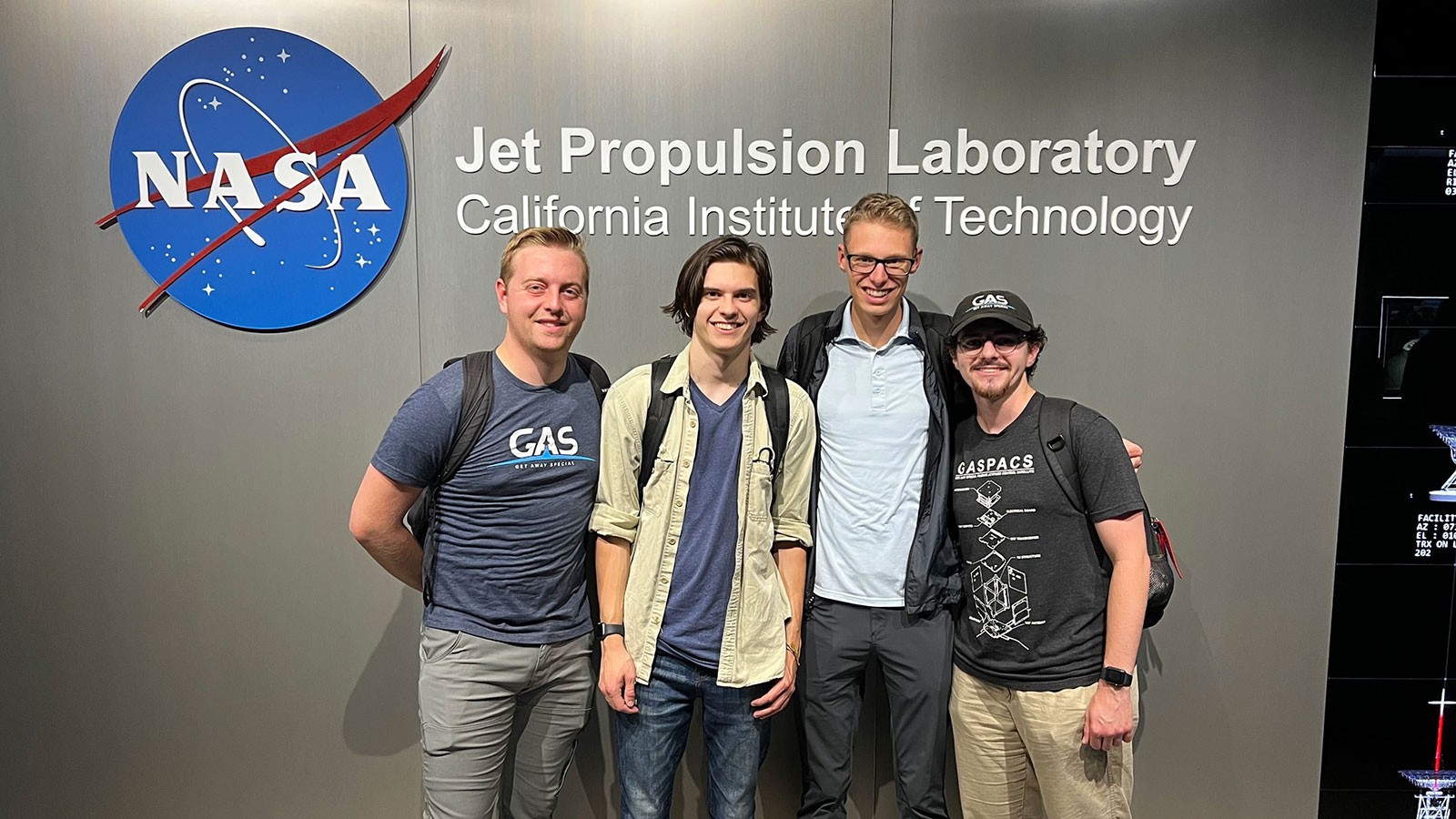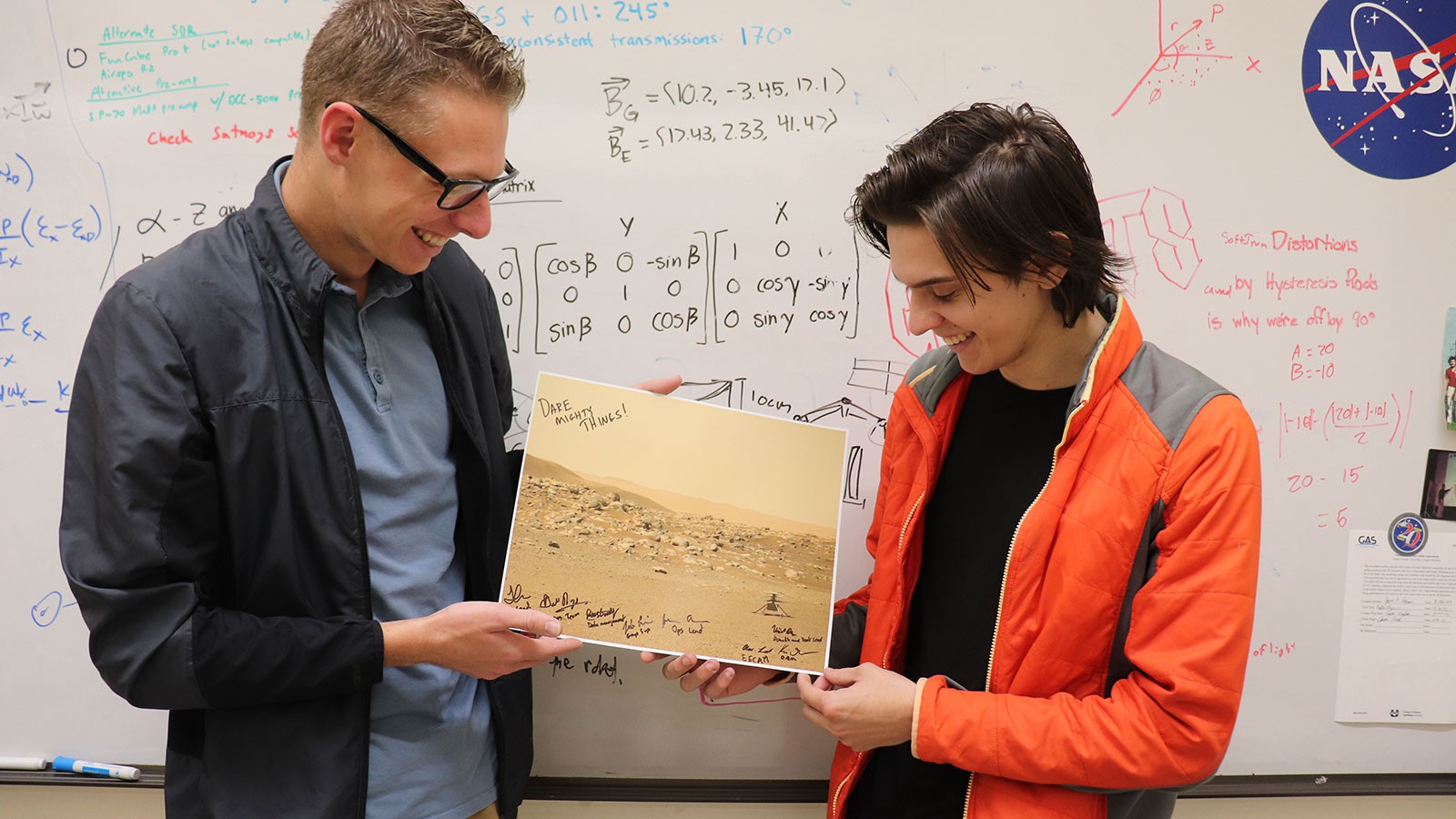USU's GAS Student Space Research Team Visits NASA Jet Propulsion Laboratory
Undergrads seek advice on satellite design from Mars researchers and tour cutting-edge aerospace facility.
By Mary-Ann Muffoletto |
From left, USU Get Away Special Team members Shawn Jones, Kade Angell, Taylor Rowser and Carter Page attended a software workshop at NASA's Jet Propulsion Laboratory in preparation for designing a satellite they hope to launch into space in 2024.
Professional contacts made at the 2022 Small Satellite Conference, held annually on Utah State University’s Logan campus, paved the way for four Aggie undergraduate researchers to visit NASA’s Jet Propulsion Laboratory, one of the world’s leading centers for robotic space exploration.
Students Kade Angell, Shawn Jones, Carter Page and Taylor Rowser, members of USU’s Get Away Special (GAS) student space research team, traveled to the renowned Caltech facility, located near Pasadena, California, for a three-day workshop in early October to learn about software they hope will drive their next satellite.
“We learned about F Prime, a free, open-source flight software framework developed by JPL, while attending the Small Sat Conference in August,” says Angell, a dual physics and computer engineering major, with minors in mathematics and consulting. “During the conference, we went to JPL’s presentation and spent a lot of time at their booth talking with their representatives, who suggested we attend an F Prime workshop for students and JPL employees.”
USU’s College of Science and College of Engineering provided travel funds for the GAS Team members, who leapt at the chance to learn about the software and rub shoulders with about 50 seasoned space researchers and 20 college students from around the country.
“Most of our time was spent in the workshop, where we were learning alongside people who’d worked on flagship Mars missions,” says Rowser, a dual computer science and marketing major who is minoring in anticipatory intelligence. “It was the most incredible atmosphere. I couldn’t believe I was discussing software bugs with crazy-smart engineers and scientists who’d designed Mars rovers.”
The GAS Team is fresh off the heels of a successful NASA-funded CubeSat mission, in which their GASPACS (Get Away Special Passive Attitude Control Satellite), carried to the International Space Station by a SpaceX rocket in December 2021, was deployed into space about a month later and completed a phenomenal 117-day journey.
The students’ new satellite design, named GASRATS (Get Away Special Radio and Antenna Transparency Satellite), will demonstrate an optically transparent, solar panel-integrated S-band patch antenna, by establishing downlink communications between the satellite and the USU GAS Team ground station. The team will soon submit a funding proposal for the project to NASA’s CubeSat Launch Initiative, the same program that funded GASPACS. If successful, the GAS Team could send GASRATS to space as early as 2024.
“GASRATS is a collaboration with Dr. Reyhan Baktur, a fantastic faculty member in USU’s Department of Electrical and Computer Engineering,” says Page, a mechanical and aerospace engineering major and student coordinator of the GAS Team. “She’s long been developing these special transparent patch antennas that can be mounted directly on top of a solar panel. It’s a cool technology that still allows more than 90 percent of light to pass through the antenna.”
The team says use of JPL’s F Prime software, rather than the proprietary code developed for the team’s first satellite, will offer more flexibility and be more cost-effective for the new project.
“GASPACS used software written almost entirely in Python by our team member Shawn Jones,” Rowser says. “It was obviously successful, but F Prime, written mostly in C++, will give us more options with its ‘plug-and-play’ structure. It will also save us a tremendous amount of time and resources, without having the develop everything from scratch, and allow us to continue to test and edit the software even after the satellite is deployed.”
During their southern California visit, the USU students toured JPL’s Mission Control (“It was nuts,” Rowser says), as well as the California Science Center, which houses the Space Shuttle Endeavour – one of four NASA shuttles, Angell notes, that carried USU GAS Team experiments into space from 1982 to 2001.
Among the cherished souvenirs the Aggies brought back from JPL is a photo taken of the Mars helicopter, Ingenuity, as it landed on the surface of the red planet in February 2021. Workshop classmates who’d worked on the landmark mission signed the USU students’ photograph, which will be framed and displayed in the GAS Team’s Science Engineering Research Building lab.
“While employees were signing the photo, a JPL engineer walked by and said, ‘Oh, that’s cool. I think I took that picture,’” Rowser says. “She was the person who operated the camera on the Perseverance rover that was deployed alongside the helicopter. We got her signature, too.”
GAS students Taylor Rowser, left, and Kade Angell display a photo of Mars helicopter Ingenuity landing on the red planet in 2021. The photo is signed by Ingenuity project employees the Aggies met during a recent visit to NASA's Jet Propulsion Lab.
WRITER
Mary-Ann Muffoletto
Public Relations Specialist
College of Science
435-797-3517
maryann.muffoletto@usu.edu
CONTACT
Carter Page
Team Coordinator
USU Get Away Special
coordinator@gas.usu.edu
TOPICS
Space 140stories NASA 83stories Satellites 67storiesComments and questions regarding this article may be directed to the contact person listed on this page.









